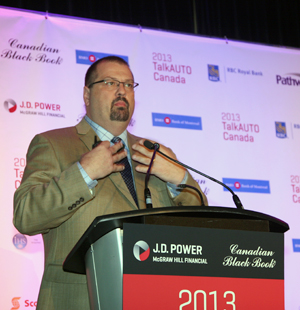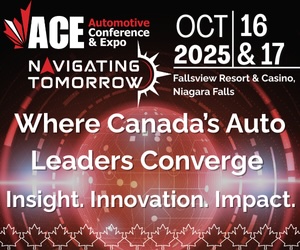PART ONE: Steady growth, more demanding consumers

Any opportunity where people get a chance to meet, network and share ideas can only serve to benefit those who attend. And so it was the case on November 14, during the second annual TalkAUTO Canada, co-presented by the folks at J.D. Power and Canadian Black Book.

Darren Slind
Taking place at the Toronto Congress Centre, a stone’s throw from Pearson Airport in Toronto, it included a wide variety of speaking sessions, networking breaks and workshops. Emcee Darren Slind, senior director and Regional Practice Leader for Canada and Latin America at J.D. Power, said the key objective with TalkAUTO since the beginning has been to create a one-day event where people in the auto industry can come together and share ideas.
Things kicked off early with a networking breakfast at 7:30 am. This was followed by an introduction and welcome address from Ray O’Kane, managing director, head of National Retail Dealer Finance at Bank of Montreal (a platinum sponsor of this event), with Larry Shred, president of Canadian Black Book and Darren Slind.
SLOW BUT STEADY
It can be hard to predict the future, especially in today’s rapidly changing world, yet Jeff Schuster, senior vice-president of Forecasting at LMC Automotive, provided some interesting observations in his Canadian automotive sector outlook presentation. Schuster said that in terms of GDP growth, the economy is expected to stay under two per cent, though the auto sector as a whole continues to perform well.
Schuster said that inflation is expected to remain low, which will continue to result in favourable interest rates. “We do see a slow growth level,” he said “but see it continuing to edge up over the years.”
In terms of the auto sector specifically, that is likely to bode well for OEMs, despite fierce competition and rapidly changing buyer tastes. Schuster noted that in terms of trends, there’s a continuing push for smaller, more fuel efficient engines in both Canada and across North America, with the big growth expected to remain in the compact car and SUV segments. “The compact segment continues to be strong,” he said “and we expect it to dominate the market.”

Jeff Schuster
He said that compared with the pre-recession marketplace, inventory levels are being managed well, creating a positive environment, though arguably, perhaps the situation is too lean, with some OEMs struggling to keep pace with demand for certain models due to production and supply constraints.
As more manufacturers continue to invest in production facilities in Mexico, Schuster said he expects North America to become more of an export hub, while a greater number of vehicles sold here, will also be built here.
IT’S THE INSIDE THAT COUNTS
In his presentation entitled: Competitive advantage through the in-car experience, Mike VanNieuwkuyk, executive director, Global Quality Practice at J.D. Power, said that based on data the firm has gathered, both from the U.S. and in Canada, one of the biggest focal points in the auto industry today concerns the in-car experience. He noted that when J.D. Power first began doing quality surveys, back in 1987, there was a significant difference in overall vehicle quality between some OEMs and others.
Today, now that quality has vastly improved across the board (the firm’s data shows 78 problems per 100 vehicles, compared to 220 per 100 in 1997 and 334 per 100 in 1987), one of the biggest ways OEMs and their dealers can differentiate themselves is by focusing on the in-car experience. He noted that in the U.S. at least, the average person spends 2 hours and 27 minutes in their vehicle, so what comfort, convenience and features that vehicle offers are hugely important.

Mike VanNieuwkuyk
VanNieuwkuyk noted that a vehicle’s cabin is likely to become an increasingly important aspect of the purchase and ownership experience, especially as a new generation of drivers get behind the wheel. “They have a different perspective,” he said. “They are tech savvy with a lifelong use of communication and media devices. They are self-identified experts at multi-tasking and expect instant action and satisfaction.” As a result, VanNieuwkuyk noted that functionality, info entertainment and connectivity aspects inside a vehicle are hugely important to them.
He also talked about safety and technology and that for consumers, features that provide security from elements outside the driver’s control receive stronger interest than those that are seen as interfering with their ability to pilot a vehicle. Gazing into the crystal ball a little, VanNieuwkuyk said that while he’s seen a shift in perception regarding autonomous vehicles — from wonder to acceptance that it is coming among consumers — manufacturers will still need to prove (and convince them) that the technology really works.
MORE TO COME
In part two of our coverage on TalkAUTO Canada, we’ll take a look at some of the vehicle market trends happening in Canada, the future of electric mobility; the issues affecting dealers, plus some interesting facts regarding long-term auto financing. We’ll also see the findings from a study performed by the winning students from the Georgian College Research Analyst Program on the dollars and sense of fuel economy for Canadian consumers and what dealers need to know when it comes to understanding the next generation buyer.

















